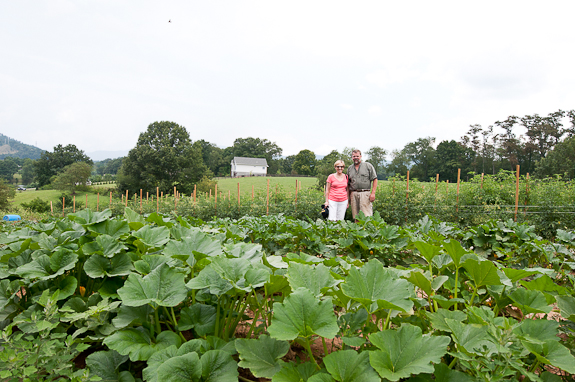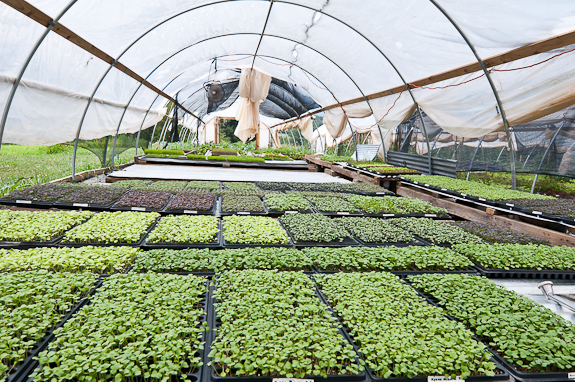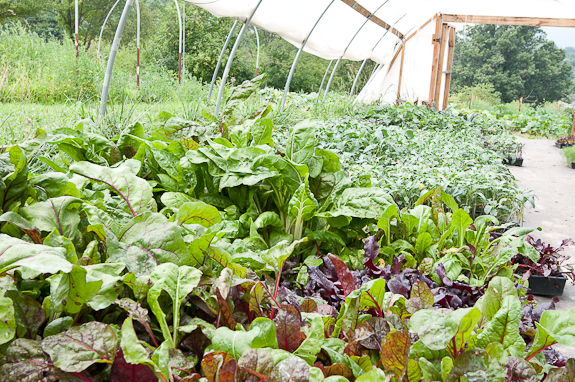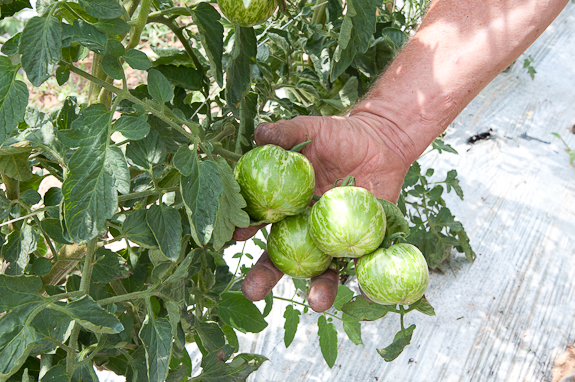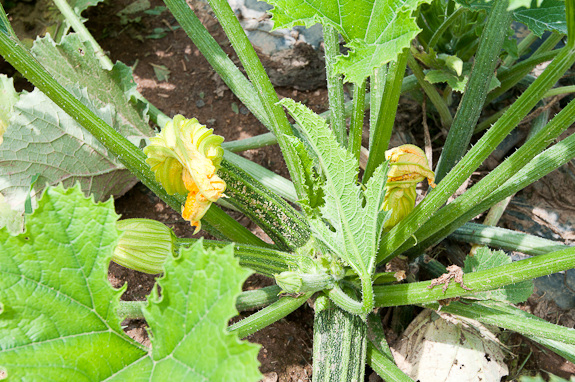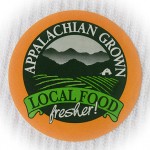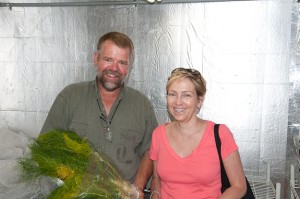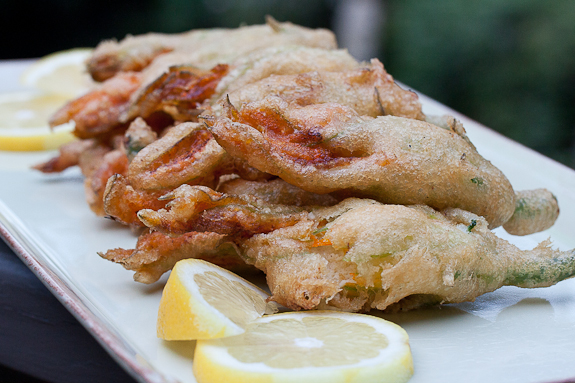Squash Blossoms From Jolley Farms To My Table!
I have always tried to make a conscious effort to purchase and eat locally grown foods. Not only does it taste better, but it also helps out the local farmers and businesses. There are obviously some things that are not available locally that I will buy or ingredients that originate elsewhere that I use in cooking (especially ethnic dishes).
However, I must say that this spring and summer I have become especially interested in the whole sustainable agriculture issue partly because of writing some of my articles for the blog. These would include my interviews with Chef Johannes Klapdohr, Chef John Fleer as well as my post on the Cashiers Farmers Market.
I have been buying local produce at the Cashiers Farmers Market for many years, but after getting to know the owners a little more from writing the article, I really was interested in discovering where some of the produce originated. After a very recent purchase of squash blossoms and some specialty squashes, I decided to go and meet the farmer that was growing some of my goodies that I love so much.
This is the first of several posts from our On The Road series. Roger and I have been wandering around on farms in miserable heat! on several road trips to talk to some of the local farmers and chefs to discuss the topics of sustainable agriculture and the Farm to Table movement.
Our first stop on the road trip was Jolley Farms, but I want to take a few minutes to tell you a little bit about Zeb and June because their past history is part of why there is a Jolley Farms. I have to tell you that we were really touched by this man’s story. It is one of perseverance and renewal. Here is a family that has adapted and changed to survive.
Zeb grew up on his grandfather’s peach farm in South Carolina and recalls spending all of his Summers working on the farm in the peach shed with all of the other 18 grandchildren.
He then married into a farming family. The land where Jolley Farms is today was originally purchased in the 1940s by June’s family and was a self-sustaining farm with chickens, hogs, cattle and of course, a vegetable garden.
When Zeb and June met in the 1970s, Zeb had been laid off from work in nuclear construction. They met while attending a horticultural program at college. After marrying, they operated a successful plant farm dedicated to growing plants and perennials for wholesale and retail customers.
In the 1990s, Lowes and Wal-Mart moved into the area and made it very difficult for a smaller farmer to compete, so after struggling with the business, Zeb went back to school again and June went to work at the North Carolina Arboretum (she is still employed there).
Zeb then was hired as as surveyor doing a great deal of wetlands surveying from 2000 to 2008. This was during the construction boom and he was involved with surveying properties for several of the local golf courses that were being built at that time as well as some other projects.
When the financial markets crashed, all of the building stopped and Zeb found himself out of work again. What would he do now? Of course, the answer was to farm the land that they had, but to do something different.
Jolley Farms is located in Canton, North Carolina (Haywood County). This five-acre farm has been in its new operation for approximately one and a half years and already has a great reputation in the Western North Carolina area for producing specialty produce and offering very personal service.
Jolley farms got its start in somewhat of an unusual way. Zeb went to an old friend and chef, Denny Trantham, and asked what he could grow for him that he could not find anywhere else (especially in the middle of winter – remember he had the equipment to grow flowers year round). This was reverse of what usually happens when a farmer shows up at the back door of a restaurant. Typically, in the spring and summer, the farmer shows up with a truckload of produce he hopes the chef has a need for.
Chef Trantham (the Executive Chef of the Grove Park Inn in Asheville, North Carolina) told Zeb that if he could grow some of the micro greens that he was ordering from Ohio, that he would give him the business locally. He also introduced him to other chefs who might be interested in his products.
In addition to the beautiful micro greens, Zeb began planting all sorts of Heirloom tomatoes and unusual squashes. He also grows those beautiful edible flowers. Through his networking and former relationships from selling flowers and plants, he is building a real niche business.
Zeb showed us around the farm pointing out all the types of produce he is growing. We also were able to get very pretty shots of his farm and produce (you knew we were going to do that).
Zeb continues to try all sorts of new varieties of micro greens, squashes and Heirloom tomatoes, so you never know what might be growing there next year.
Jolley Farms is certified by the Appalachian Sustainable Agriculture Project. “ASAP helps create and expand local food markets that will preserve our agricultural heritage, give everyone access to fresh, healthy food, and keep our farmers farming. Our mission is to help local farms thrive, link farmers to markets and supporters, and build healthy communities through connections to local food.”
As Zeb says, we have to be realistic that we cannot grow everything here, but he is certainly trying to grow what he can and sell it “locally”, which is defined as within 100 miles.
What I find impressive is that Zeb is able to grow some of his produce almost through the entire winter by growing it in low tunnels. He said that even with several feet of snow between the tunnels last year (it was the worst winter in 10 years in the area), he still had lettuces and micro greens growing that he was able to offer his customers. That is really amazing.
He will also have pumpkins, squash (Delicata and Hubbard) and winter greens coming up this fall. Those are some of my favorites, so I can’t wait to see them (and some cooler temps) in the farmers market this fall.
I would like to thank Zeb for taking the time out of his very busy schedule to show us around his farm. (He works with just two other people that help him cut, wash, pack and deliver all of this wonderful produce, so he is a very busy guy.) His family’s story is truly inspiring and his produce is delightful.
Large corporate farming has displaced many of our small family farms. It is difficult for a smaller farmer to stay in business with the way food is manufactured and delivered today. However, it is these small family farms that produce the quality and freshness in our produce that we are looking for. Now that there is a revival of small farms, especially in the Western North Carolina area, I am trying to support them as much as possible. I hope you will do the same wherever you are.
From Zeb’s farm to my table, here is a recipe for Stuffed Squash Blossoms (oh, they are soooo good!). These are adapted from Jamie Oliver’s recipe. The recipe for this batter is a calorie killer keeper!
Enjoy!
If you are interested in reading more about eating locally and the Farm to Table movement, here are some books I recommend. They are available through Amazon.com.
Local Flavors: Cooking and Eating From America’s Farmers’ Markets
Chefs on the Farm: Recipes and Inspiration from the Quillisascut Farm School of the Domestic Arts
Fresh from the Farmers’ Markets
The Art of Simple Food: Notes, Lessons, and Recipes from a Delicious Revolution
The Food Revolution: How Your Diet Can Help Save Your Life and Our World
Slow Food Revolution: A New Culture for Eating and Living
The Berkshires Farm Table Cookbook: 125 Homegrown Recipes from the Hills of New England
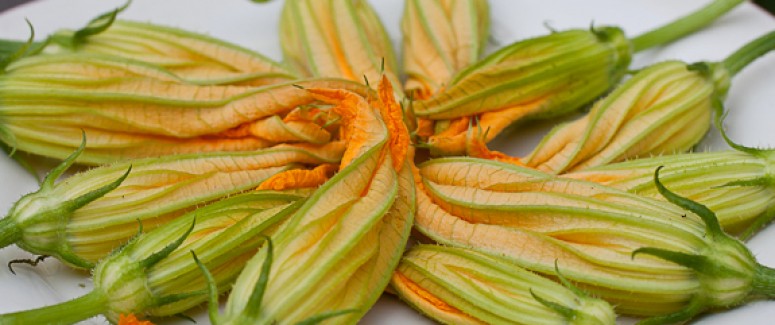
Ricotta Stuffed Squash Blossoms
Serves 4
Ingredients:
Filling
12 ounces part-skim ricotta cheese
1 large egg, slightly beaten
1/2 cup freshly grated Parmigiano-Reggiano
Finely grated, or a pinch of ground nutmeg
Grated zest of 1/2 lemon
Salt and freshly ground black pepper, to taste
Batter
1 3/4 cups self-rising flour, plus a little extra for dusting
1 1/2 cups white wine or sparkling water (I used sparkling water and drank the wine!)
12 squash blossoms
Vegetable oil
Small piece of potato, peeled (optional)
2 lemons, halved
Directions:
For filling:
Mix together the ricotta in a bowl with the egg, Parmigiano-Reggiano, nutmeg and lemon zest. Season to taste.
For batter:
To make a lovely light batter, put the flour into a mixing bowl with a good pinch of salt. Pour in the sparkling water and whisk until thick and smooth. At this point the consistency of the batter should be like heavy cream or, if you dip your finger in, it should stick to your finger and nicely coat it. If it’s too thin, add a bit more flour; if it’s too thick, add a little more sparkling water.
To prepare:
Open the squash blossoms gently and snip off the pointed stamen inside because it tastes bitter. Give the flowers a gentle rinse if you like.
Spoon the ricotta into the corner of a plastic sandwich or Ziploc bag. Snip 1/2 inch off the corner and use this as a makeshift piping bag to gently squeeze the filling into each flower, until just full. Carefully press the flowers back together around the mixture to seal it in. Then put the flowers to one side. (Any leftover ricotta can be smeared on hot crostini as a snack.)
Now for the deep-frying: Have tongs or a spider ready for lifting the flowers out of the oil, and a plate with a double layer of paper towels on it for draining. Pour the oil into a deep-fat fryer or deep saucepan so it’s about 2 inches deep. Heat it up to 350F or, if using a saucepan, put in your piece of potato. As soon as the potato turns golden, floats to the surface and starts to sizzle, the oil is just about the right temperature. Remove the potato from the pan.
One by one, dip the ricotta-stuffed squash blossoms into the batter, making sure they’re completely covered, and gently let any excess drip off. Carefully release them, away from you, into the hot oil. Quickly batter another one or two blossoms and add them to the pan, but don’t crowd the pan too much or they’ll stick together. Fry until golden and crisp all over, then lift them out of the oil and drain on the paper towels. Remove to a plate or board. Serve with half a lemon to squeeze over.

